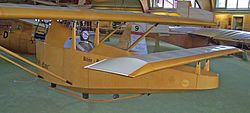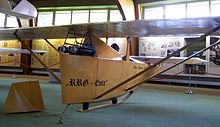Lippisch duck
| Lippisch duck | |
|---|---|

|
|
| Type: | Rocket plane |
| Design country: | |
| Manufacturer: | |
The duck was one of many revolutionary designs by Alexander Lippisch . Originally founded as a glider built aircraft in canard construction ended on 11. June 1928 with the first manned rocket flight in aviation history one. Since the design managed without a conventional tail unit at the stern, the duck was particularly suitable for experiments with a rocket drive .
history
Fritz Stamer was selected as the pilot because he was Lippisch's test pilot for its aircraft. The first manned rocket flight took place on June 11, 1928 on the Wasserkuppe . A first attempt to start that day failed. The plane didn't take off and the missile just burned out. In the second attempt, Friedrich Stamer flew about 1.5 km in the aircraft equipped with two solid fuel rockets. However, the start was made with a rubber rope. The two rockets, equipped with 4 kg of powder, were electrically ignited one after the other by switches in the cockpit and each provided thrust for 30 seconds. A counterweight under the fuselage compensated for the shift in center of gravity caused by the burning of the fuel. The flight lasted only about 80 seconds in total.
On the third attempt to fly, an attempt was made to launch both rockets at the same time, but one of the rockets exploded and the aircraft caught fire. However, Stamer was able to land unharmed from a height of 20 meters and escape while the plane burned completely. No further attempts were made with a duck . The aim of these experiments was to develop an alternative launch method for gliders.
The project was funded by Opel. The rockets came from Friedrich Wilhelm Sander , who with Fritz von Opel made numerous experiments with solid rockets as propulsion. Alexander Lippisch later developed, among other things, the Messerschmitt Me 163, the first mass-produced rocket aircraft.
Von Opel then contacted Julius Hatry in order to design the Rak. 1 , another glider specifically for rocket launches.
Replica of the Stamer-Lippisch rocket duck
In September 2007, members of the German Glider Museum with model flight on the Wasserkuppe in the Rhön completed the voluntary replica project of the rocket duck in the German Glider Museum on the Wasserkuppe. The replica is true to the original as the only copy worldwide and as a milestone in the history of the Wasserkuppe and space travel in the redesigned rotunda of the museum for the public. The RRG was the Rhön-Rossitten-Gesellschaft .
Technical specifications
| Parameter | Data from the RRG rocket duck |
|---|---|
| crew | 1 |
| length | 4.31 m |
| span | 11.94 m |
| Wing area | 20.3 m² |
| Wing extension | 7.0 |
| Engines | 2 × 20 kg solid rockets |
See also
Web links
Individual evidence
- ↑ RRG Rocket Duck. German Glider Museum, archived from the original on January 30, 2018 ; accessed on June 13, 2018 .

